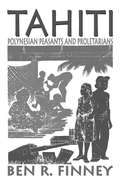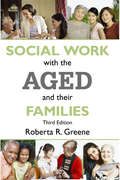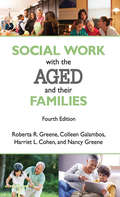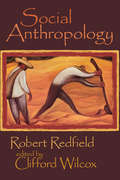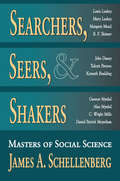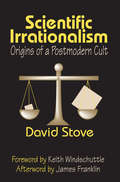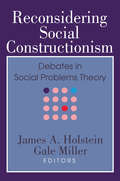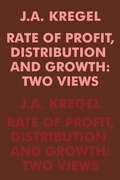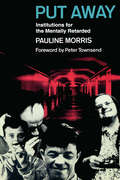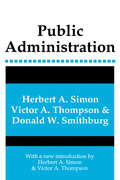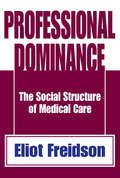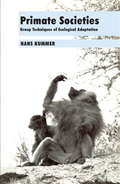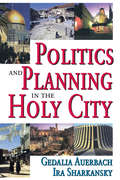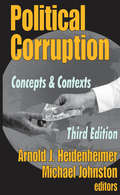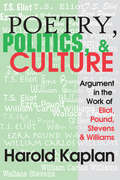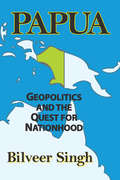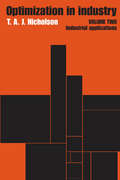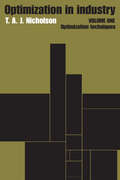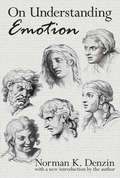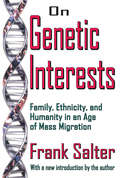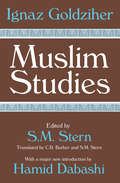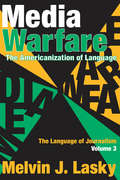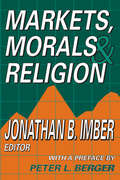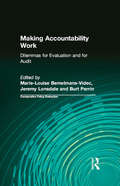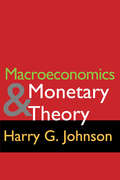- Table View
- List View
Tahiti: Polynesian Peasants and Proletarians
by Ben R. FinneyThe Polynesian island of Tahiti is in the imagination an island paradise, an idyllic world inhabited by noble savages, carefree and uncomplicated. Tahiti separates myth from reality. Finney describes and analyzes the forces of change that have confronted Tahiti and its inhabitants in the modern world. As the author notes in the introduction, "Neither isolation in the South Pacific, nor the romantic aura invested in them by philosophers and escapists of the West, has saved Tahitians from intense involvement in the twin processes of industrialization and urbanization."This study of Tahitian life concentrates upon two different communities. One is a peasant community moving from subsistence farming to an increased reliance upon the production of cash crops. The other is a proletarian community whose members were at the time abandoning farming and fishing in favor of wage labor. Finney compares the two contemporaneous communities, enabling him to define different but interrelated variables of the economic and social change. These are responsible for Tahiti's evolution from a subsistence oriented peasant life to a life based increasingly on cash crops and wage labor.What happens to family life, work patterns, land use, and other traditional modes of social organization when a small, underdeveloped society is confronted with economic forces largely beyond its control? In dealing with this question as it applies to Tahiti, Finney makes an important contribution to our understanding of how modernization affects a society once thought to be outside the boundaries of the modern world. A major study in English of the socio-economic forces at work in Tahiti, this book provides the reader with both an understanding of the changing nature of Tahitian life, and the reactions of Tahitians to such changes.
Social Work with the Aged and Their Families
by Roberta R. GreeneIn recent years, theoreticians, researchers, and practitioners have become increasingly interested in older adults and the aging process. This volume draws on related disciplines to better understand the biological, psychological, and social aspects of aging. 'Social Work with the Aged and Their Families' covers areas of central interest to those coping with the needs of an aging population. Among the topics addressed are assessment of the aging, taking into account biological age, psychological age, and socio-cultural and spiritual age. Greene also considers the importance of the family system, family roles and development, functional-age individual and family intervention, and group and community interventions. The scientific and systematic study of aging is known as gerontology. Geriatric social workers are those who have applied established social work theories in an attempt to find suitable techniques for working with their elderly clients. The need for specialized services has given birth to various services and programs. For example, meals-on-wheels and home health care services have been designed to meet specific physical needs of older adults. However, mental health services have lagged far behind as practitioners struggled to adapt such specialties as family therapy to families of later years. A major contribution of this book, now in its third edition, is the functional-age model of intergenerational treatment (FAM), which is an outgrowth of that demand. The functional-age model of intergenerational treatment is an integrative theoretical framework for social workers interested in clinical social work practice with older adults and their families. Since its initial construction in 1986, the model has been augmented by more recent concepts related to successful aging, spirituality, and resiliency. These additions, together with the original assessment and intervention strategies, present the major converging conceptual trends that constitute a model for twenty-first century social work practice in the field of aging.
Social Work with the Aged and Their Families
by Roberta R. GreeneSocial Work with the Aged and Their Families presents the functional-age model (FAM) of intergenerational treatment, an integrative theoretical framework for social workers practicing with older adults and their families. In keeping with the Council on Social Work Education's curriculum mandate of 2015, social workers are now encouraged to use human behaviour theories in working with their geriatric clients. This fourth edition incorporates much-needed additional techniques to address the mental health assessments of the elderly. FAM addresses the assessment of older adults' biological, psychological, socio-cultural, and spiritual age. It also incorporates an evaluation of the family system, family roles, and family development in this assessment. Interventions at the individual, family, group, and community levels are discussed. This volume, augmented with recent concepts related to successful aging, spirituality, and resiliency, presents the major converging conceptual trends that constitute a model for twenty-first century social work practice in the field of aging. It is an indispensable text for those training in social work practice with the elderly, or those currently in practice.
Social Anthropology: Robert Redfield (University Of Chicago Publications In Anthropology. Social Anthropology)
by Clifford WilcoxRobert Redfield is remembered today primarily as an anthropologist, but during his lifetime Redfield's cross-disciplinary activity reflected a strong interest in infusing anthropological practice with sociological theory. Like a handful of other anthropologists, including A.R. Radcliffe-Brown and Bronislaw Malinowski, who shared his interests during the 1920s through 1930s, his works came to define a new subfield known as social anthropology.Redfield was distinct in being one of the first Americans to devote himself seriously to social anthropology, a field dominated initially by British scholars. He spent his career at the University of Chicago, and his anthropology bore the distinct mark of sociology as developed and practiced at that institution. Indeed, Redfield played a major role in defining what has been called the second Chicago school of sociology. This volume brings together Redfield's most important contributions to social anthropology.During the 1920s, sociology and anthropology constituted a single department at the University of Chicago. Although most students concentrated on sociology or anthropology, Redfield chose to pursue both fields with equal intensity. He adopted as his central interest the leading problematic of the 1920s: the study of social change. Chicago School sociologists approached social change by examining zones of rapid transition within the city, for example, areas populated by recently-arrived immigrants, with the goal of elucidating general principles or dynamics of social transition.Redfield's work can be seen as falling into three distinct theoretical categories: (1) the study of social change or modernization; (2) peasant studies; and (3), the comparative study of civilizations. Drawing from articles, book excerpts, and unpublished papers and letters, this work presents Redfield's central contributions in each of these areas. Seen as a whole, this volume traces Redfield's seminal contributions to the early development of mo
Searchers, Seers, and Shakers: Masters of Social Science
by James A. SchellenbergThis volume offers intellectual portraits of eleven giants of the modern social sciences. It is bound by two central themes. The first is that there is a fundamental unity behind the various forms of social science. There is a general social science as well as a variety of social science disciplines. The second theme is that a biographical approach is a useful tool for making clear some of the central ideas of social science. By looking at the lives and achievements of selected masters, we should be better able to understand the fundamental nature (or natures) of social science.In order to determine which figures should be regarded as masters Schellenberg defines the three main kinds of work he sees as central for social science. First is the work of basic discovery done by searchers who made especially important contributions to empirical work in the social sciences. The persons he selected for special treatment here are Louis Leakey, Mary Leakey, Margaret Mead, and B. F. Skinner. He then considers the work of theory, choosing for examination seers who had made especially important theoretical contributions: John Dewey, Talcott Parsons, and Kenneth Boulding.Schellenberg next examines those social scientists who worked to seek changes in society. These were the shakers or social reformers. In Schellenberg's view these come in three main subtypes, and he sought to include at least one example of each--Gunnar Myrdal and Alva Myrdal as social engineers, C. Wright Mills as a rebellious social critic, and Daniel Patrick Moynihan as one whose contribution was made more directly into the world of politics.Schellenberg's exploration of the lives of these eleven masters of twentieth-century social science reveals many surprises and ironies. While he points out major contributions, he also has felt free to make criticisms. As he has said: These were all real persons, with failings and foibles, as well as persons of great achievement. I felt that the examination of
Scientific Irrationalism: Origins of a Postmodern Cult
by David StoveLittle known outside his native Australia, David Stove was one of the most illuminating and brilliant philosophical essayists of his era. A fearless attacker of intellectual and cultural orthodoxies, Stove left powerful critiques of scientific irrationalism, Darwinian theories of human behavior, and philosophical idealism.Since its inception in the 1940s, the field of science studies, originally intended to bridge the gap between science and the humanities, has been the center of controversy and debate. The most notable figures in this debate are Thomas Kuhn and Karl Popper. In Scientific Irrationalism, now available in paperback, David Stove demonstrates how extravagant has been the verbiage wasted on this issue and how irrational the combatants have been. He shows that Kuhn and Popper share considerable common ground. Stove argues that the problems all reside in the reasoning of the critics. He identifies the logical mistakes and conceptual allusions made by Kuhn and Popper and their supporters, as well as their collective dependency on a single argument made by the philosopher of the Scottish Enlightenment, David Hume. He then demonstrates how little potency that argument actually has for the claims of science.In his foreword, Keith Windschuttle explains the debate surrounding the field of science studies and explores David Stove's contribution as well as his lack of recognition. In an afterword, James Franklin discusses reactions to Stove's work.
Reconsidering Social Constructionism: Social Problems and Social Issues (Social Problems And Social Issues Ser.)
by Gale MillerWith the impact of social interactionist and ethnographic methodology twenty-five years ago, the research agenda in social problems began to shift its focus, giving rise to the Social Constructionism movement. The present volume and the related shorter text, Constructionist Controversies, review the substantial contributions made by social constructionist theorists over that period, as well as recent debates about the future of the perspective. These contributions redefine the purpose and central questions of social problems theory and articulate a research program for analyzing social problems as social constructions. A generation of theorists has been trained in the constructionist perspective and has extended it through numerous analyses of diverse aspects of contemporary social life.The debates in this volume pose fundamental questions about the major assumptions of the perspective, the ways in which it is practiced, and the purposes of social problems theory. Their point of departure is Ibarra and Kitsuse's essay, cutting new theoretical ground in calling for ""investigating vernacular resources, especially rhetorical forms, in the social problems process.""Contributors are forceful proponents both within and outside of the social constructionist community, who take a broad array of positions on the current state of social problems theory and on the rhetorical forms that need exploring. They also lay down the general lines for diverse and often competing programs for the future development of the constructionist agenda.
Rate of Profit, Distribution and Growth: Two Views
by J.A. KregelA controversy among economists has raged in the pages of professional journals for the last decade. The debate concerns capital theory and distribution theory, as well as interpretation of models of long-run economic growth. This book is an attempt to integrate recent developments in capital theory and show their implications for models of long-run economic growth in mature capitalistic countries.This book first presents the von Neumann model and outlines its classical approach to the rate of profits and distribution. Sraffa's resolution of the value-price transformation problem is then presented and compared with Samuelson's ""Surrogate Production Function"". With the results of this comparison and the delineation of the special case in which the ""Surrogate"" is valid, several existing models of growth are set out in two representative groups.Neoclassical models form the first group. These are defined by their reliance on marginal theory to determine factor prices, the rate of profit and therefore distribution via the perfectly differentiable production function. Models of Meade, Tobin, Solow, and Samuelson- Modigliani are outlined and analyzed for their treatment and distribution and profits theory. The second group is comprised of models within the strict Keynesian tradition. The basic groundwork of these models as found in the work of Keynes and Kalecki is first cited. The Keynesian models are characterized by their assumption that the investment decision is totally independent of savings decisions in the economy. The models of Harrod, Kaldor, Pasinetti and Joan Robinson are presented and their method of approach to the rate of profits and distribution is analyzed.The concluding chapter focuses on some criticisms brought against the Keynesian models and offers some generalized formulations to deal with these neoclassical objections. General conclusions follow the treatment of each representative group and author.
Put Away: Institutions for the Mentally Retarded (International Library Of Sociology Ser.)
by Pauline MorrisThis classic book allows its readers for the first time to comprehend the size, organization, staffing and operation of a national system of hospitals and residential services for the subnormal. It also allows for the first time, reliable estimates to be given of the scale and severity of certain problems. The basis has been laid for an evaluation of the effectiveness of hospitals for the subnormal. All this has been made possible by a generous grant from the National Society for Mentally Handicapped Children to the Department of Sociology in the University of Essex upon the foundation of the University. Of course, a great deal of further research remains to be done but a preliminary network of information is now available to all those deeply concerned about the handicapped.This is a study of the range and quality of institutional provisions made in England and Wales for that group of handicapped individuals who are known as mentally deficient. Dr. Morris reports on an investigation, which covered nearly half the hospitals for the sub-normal in the country: many of its findings can only shock and dismay.The investigation was concerned to discover what facilities-physical, occupational and educational-there was for patients, and to learn more about their social environment. It was also concerned to determine the extent to which both staff and patients are affected by their social environment, and by administrative action, and to learn something of the relationship between the hospital as an institution and the outside community, as well as between the patients and the outside world. In addition, it examined the extent to which the provisions and facilities available met the needs of the patients in relation to their physical and mental handicaps.
Public Administration
by Herbert A. Simon Donald W. Smithburg Victor A. ThompsonAt the time of its initial publication, Public Administration helped to define this field of study and practice by introducing two major new emphases: an orientation toward human behavior and human relations in organizations, and an emphasis on the interaction between administration, politics, and policy. Without neglecting more traditional concerns with organization structure, Simon, Thompson, and Smithburg viewed administration in its behavioral and political contexts. The viewpoints they express still are at the center of public administration's concerns.
Professional Dominance: The Social Structure of Medical Care
by Eliot FreidsonIn the United States today we are confronted by a number of serious social problems, not the least of which concern the character of our basic human services. In each of the broad public domains of welfare, education, law, and health there are crises of public confidence. Each in its own way is failing to accomplish its essential mission of alleviating material deprivation, instructing the young, controlling and righting criminal and civil wrongs, and healing the sick. The poor, the student, the offender and the victim, the sick-all have in some way protested the failure of the institutions responsible for them. And these protests occur at a time when the human services are absorbing an increasingly massive amount of money and manpower. Awareness of that crisis intensified in the second half of the twentieth century. Increasing energy has been invested in research designed to determine what can be done. Each of the human services has long had its own research tradition, but during the sixties each has also made a concerted effort to mobilize and use the skills of such comparatively new disciplines as sociology. Owing to these new demands, sociology itself has grown. The hitherto obscure specialties of the sociology of law and medicine and the established specialties of criminology and educational sociology have taken on new vigor. In applying themselves the task of studying the human services, however, these segments of sociology have had to choose between two different strategies. Rather than dealing with the details of the human services for their own sake-and this lack of detail in a characteristic limitation of the second approach-this book shall instead attempt to stand outside the system in order to delineate one of its critical assumptions and a strategic feature of its basic structure. This book deals with the concept of profession, for the concept rests on assumptions about how services to laymen should be controlled and is realized by a special kind of
Primate Societies: Group Techniques of Ecological Adaptation (Worlds Of Man Ser.)
by Hans KummerIn this book, Hans Kummer, one of the world's leading primate ethologists, examines the patterns of social interaction among primates. He examines this social behavior from the fundamentally biological viewpoint of evolutionary adaptation as part of the survival mechanisms for the species. Recognizing that all activity is constituted in part of genetic programming and in part of adaptive behavior, he explores the borderline area between the genetic and the "cultural." By use of astute observation and clever experimentation he shows that many aspects of social behavior are inherited, and differentially inherited among various primate groups. These data also show, however, that the individuals and troops learn much in primate social life and that these forms are responsive to particular ecological situations. Drawing heavily on knowledge gleaned from his own well-known studies of the Hamadryas baboon, Dr. Kummer introduces the reader to the daily life of a particular primate society. From this sample case, he proceeds to a more general characterization of primate societies, using as examples the great apes and monkeys of Africa, Asia, and South America and particularly the widely studied terrestrial monkey species. The particularities of primate communication, social structure, and economy are described and special attention is devoted to the primate counterparts of kinship and age groups-behavioral differences based on age and sex, and mating and grouping systems. This is followed by a chapter dealing with the ecological functions of the major parameters of primate social life, such as group size and the coordination of activities within it-dominance, leadership systems, and spatial arrangements. The second part of the book is concerned with the origins of behavioral traits of primates, discussed from phylogenetic, ecological, and cultural points of view, again using data-based examples. Dr. Kummer explains why some traits have not evolved that would have been ada
Politics and Planning in the Holy City
by Gedalia Auerbach Ira SharkanskyJerusalem is not just another city that illustrates the conflict between interests of professional planners and competing political perspectives. It is the Holy City, with a history of some 3,000 years. Moreover, numerous layers of historical remains have importance for intense and competitive religious and national interests. Israelis claim it as the capital of their country, and Palestinians want it--or part of it--as the capital of their not yet created state.Jerusalem is also a place where more than 700,000 people live, and the center of a metropolitan area with more than twice that number. Along with religious and national interests, there are the customary conflicts between what various groups--property developers, politicians, professional planners, neighborhood residents, and environmental activists--want to do with the land. Politics and Planning in the Holy City describes and analyzes the tensions between politics and planning.The authors tackle the economic, social, and political contexts that shape conflicts. Such problems include deciding what should be called Jerusalem and difficulties surrounding the construction of a defense barrier to protect Israelis from Palestinian terrorists--in the framework of a multicultural city where 30 to 40 percent of its residents are Palestinians. There is dissent over locating rail lines to the city, as some interests want them here, there, or nowhere, and over building a light rail line within a city already crowded and beset with conflicting interests. The creation of a football stadium is another venue for conflict, as many religious Jews view sports as a threat to their way of life.Issues include locating a site for housing new immigrants, as few Jerusalemites want large numbers of newcomers in their neighborhoods, and deciding which sites merit preservation in a city with many deserving candidates, but severely limited resources. This volume will attract urban specialists as well as those concerned with larger p
Political Corruption: Concepts and Contexts
by Arnold J. Heidenheimer Michael JohnstonCorruption is once again high on the international policy agenda as a result of globalization, the spread of democracy, and major scandals and reform initiatives. But the concept itself has been a focus for social scientists for many years, and new findings and data take on richer meanings when viewed in the context of long-term developments and enduring conceptual debates. This compendium, a much-enriched version of a work that has been a standard reference in the field since 1970, offers concepts, cases, and fresh evidence for comparative analysis.Building on a nucleus of classic studies laying out the nature and development of the concept of corruption, the book also incorporates recent work on economic, cultural, and linguistic dimensions of the problem, as well as critical analyses of several approaches to reform. While many authors are political scientists, work by historians, economists, and sociologists are strongly represented. Two-thirds of the nearly fifty articles are based either on studies especially written or translated for this volume, or on selected journal literature published in the 1990s. The tendency to treat corruption as merely a synonym for bribery is illuminated by analyses of the diverse terminology and linguistic techniques that help distinguish corruption problems in the major languages. Recent attempts to measure corruption, and to analyze its causes and effects quantitatively are also critically examined. New contributions emphasize especially: corruption phenomena in Asia and Africa; contrasts among region and regime types; comparing U.S. state corruption incidence; European Party finance and corruption; assessments of international corruption rating project; analyses of international corruption control treaties; unintended consequences of anti-corruption efforts. Cumulatively, the book combines description richness, analytical thrust, conceptual awareness, and contextual articulation.
Poetry, Politics, and Culture: Argument in the Work of Eliot, Pound, Stevens, and Williams
by Harold KaplanA salient feature of modern poetics is its direct connection with cultural history and politics. Among the great American poets of the twentieth century, Wallace Stevens and William Carlos Williams offer a significant contrast with T. S. Eliot and Ezra Pound. Where the latter advocated a theocentric or reactionary response to the cultural crises of modernity, the former affirmed an essentially humanist and democratic social and aesthetic ethos. In Poetry, Politics, and Culture, Harold Kaplan offers a penetrating comparative study of these representative and distinctively influential poets.All four poets wrote in an atmosphere of cultural crisis following World War I, caught as they were between outmoded belief systems and various forms of artistic and political nihilism. While each believed in poetry as a source of cultural values and beliefs, they nevertheless experienced loss of confidence in their own vocation in a world characterized by scientific, rationalist thinking and the mundane struggle for survival. For each, therefore, the poetic imagination was a means of restoring order, or building a new civilization out of chaos. In trying to define a revitalized culture, the four exemplified the perennial quarrel between Europe and America.
Papua: Geopolitics and the Quest for Nationhood
by Bilveer SinghThe Papuan conflict has been on the international radar screen since Indonesia became an independent state in 1945. Since the surrender of the territory of Papua to Indonesia in 1962, a low-intensity military conflict has been building. Most Papuans believed that their right to self-determination was sacrificed on the altar of geopolitics. Later, when East Timor seceded peacefully from Indonesia, Papuans expected the same right. When this did not happen, the conflict intensified. In this pivotal work, Bilveer Singh examines the history of the Papuan struggle, and approaches to conflict resolution through the framework of its geopolitical implications. Asserting that the Papuans were treated unjustly by Indonesia and the international community, it is not surprising that many have come down squarely on the side of Papuan independence as a way out of the imbroglio. While to some extent the Papuan's case cannot be denied, definite political and strategic realities should not be ignored. Unfortunately for the Papuans, their territory has immense geopolitical, geostrategic, and economic significance - not only for Indonesia, but also for others such as the United States, China, Australia, and a number of European countries. Papua is wealthy, under-populated and backward in terms of human resource development. Its future as a distinct entity is in real danger as the Papuans are becoming the minority in their own homeland. Due to the asymmetry of power, the Papuans' struggle has not made a breakthrough that would force Indonesia to rethink the future of the territory in any fundamental way. In order to unravel the dynamics involving Papuan separatism, this study describes the Papuan political landscape. Singh explains what makes Papua unique, and how its makeup has affected the territory's political dynamics. He analyzes the emergence of Papua as a geopolitical trophy, calling into question the degree to which Papuan nationalism has crystallized. Finally, he questions whether Papua is emerging as a regional flashpoint, and, in view of its geopolitical importance, the various options available. "Papua: Geopolitics and the Quest for Nationhood" will be of interest to scholars of international relations, comparative politics of Indonesia and the Asia-Pacific, and policymaking.
Optimization in Industry: Volume 2, Industrial Applications
by T.A.J. NicholsonThe origin of any industrial optimization study lies in the theory that some improvement can be made in a controllable system. The possibility for improvements may arise in any context, for example, in the control of a chemical plant, the organization of production to meet delivery dates, the design of rubber compounds, in traffic signal settings, and so on. In this volume, T. A. J. Nicholson deals with applications of the industrial optimization techniques demonstrated in the first volume of this two-part project, Optimization in Industry: Optimization Techniques.Applications are classified by their main functional areas in industrial planning, design, and control. The fields covered are machine sequencing, stock control and scheduling, plant renewal, distribution, financial problems, and chemical process control and design. These last two, in particular, are subjects often overlooked in operations research curricula. In each field the place and status of optimization techniques is first described and then a wide range of realistic case studies and examples are reviewed, many of them international. The problems given in this volume are primarily concerned with formulation not with solution; the task is to formulate the problems to be solved by one or more of the methods described in volume one.By connecting the optimization techniques with their applications, the gap between the people devising the methods and the people who actually need to use them is bridged. As with the first volume, this text is also supported by new exercises and model answers making this book important as an introduction to the application of optimization techniques for students as well as a reference work for the practitioner.
Optimization in Industry: Volume 1, Optimization Techniques
by T.A.J. NicholsonAs optimization techniques have developed, a gap has arisen between the people devising the methods and the people who actually need to use them. Research into methods is necessarily long-term and located usually in academic establishments; whereas the application of an optimization technique, normally in an industrial environment, has to be justified financially in the short term. The gap is probably inevitable; but there is no need for textbooks to reflect it. Teaching of optimization techniques separately from their connection with applications is pointless. This book gives a detailed exposition of the techniques.In this first volume, T. A. J. Nicholson demonstrates the full range of techniques available to the practitioner for the solution of varying problems. For each technique, the background reasoning behind its development is explained in simple terms; where helpful it is supported by a geometrical argument; and the iterative algorithm for finding the optimum is defined clearly. These steps enable the reader not only to see plainly what is happening in the method but also to reach a level of understanding necessary to write computer programs for optimization techniques.Problems are tackled in the same way--by searching a feasible region for an optimum. This approach helps the reader to develop the most essential of all skills--selecting appropriate techniques for different circumstances. The numerous worked examples in the text, supported by worked solutions, and the exercises at the end of the chapters are important aids to learning and to teachers. This book serves as an introduction to optimization techniques for students as well as a reference work for the practitioner in business and industry.
On Understanding Emotion
by Melvin J. LaskyEmotions--fleeting, insubstantial, changeable, and ambiguous--seem to defy study and analysis. Nothing is more complex, mysterious, and subject to conflicting theories and interpretations than human emotion. Yet the central importance of emotion in human affairs is undeniable. Emotions affect all levels of life--personal, organizational, political, cultural, economic, and religious. Emotions give meaning to life. Emotional disturbances can destroy that meaning.How should emotions be studied? How can an understanding of the inner feelings of individuals illuminate important social interactions and human developments? In his book, Norman Denzin presents a systematic, in-depth analysis of emotion that combines new theoretical advances with practical applications. Based on an intensive, critical examination of classical and modern theoretical research--and on revealing personal interviews in which ordinary people express their emotional lives--he builds a new framework for understanding ordinary emotions and emotional disturbances.Denzin analyzes how people experience joy and pain, love and hate, anger and despair, friendship and alienation--and examines the personal, psychological, social, and cultural aspects of human emotion to provide new perspectives for understanding human experience and social interactions. He offers new insights on the role of emotions in family violence and recommends ways of helping people escape from recurring patterns of violence. And in criticizing current conceptions of emotionally disturbed people, he reveals the nature of their inner lives and the ways they perceive and relate to others. In sum, this book presents new insights on human relationships and human experience. It is now available in paperback for the first time, with a new introduction by the author.
On Genetic Interests: Family, Ethnicity and Humanity in an Age of Mass Migration
by Frank SalterFrom an evolutionary perspective, individuals have a vi- tal interest in the reproduction of their genes. Yet this interest is overlooked by social and political theory at a time when we need to steer an adaptive course through the unnatural modern world of uneven population growth and decline, global mobility, and loss of family and communal ties. In modern Darwinian theory, bearing children is only one way to reproduce. Since we share genes with our families, ethnic groups, and the species as a whole, ethnocentrism and humanism can be adaptive. They can also be hazardous when taken to extremes. On Genetic Interests canvasses strategies and ethics for conserving our genetic interests in an environmentally sustainable manner sensitive to the interests of others.
Muslim Studies: Volume 1
by George McCueThis is the first volume of Goldziher's Muslim Studies, which ranks highly among the classics of the scholarly literature on Islam. Indeed, the two volumes, originally published in German in 1889-1890, can justly be counted among those that laid the foundations of the modern study of Islam as a religion and a civilization. The first study deals with the reaction of Islam to the ideals of Arab tribal society, to the attitudes of early Islam to the various nationalities and more especially the Persians, and culminates in the chapter on the Shu'ubiya movement which represents the reaction of the newly converted peoples, and again more especially the Persians, to the idea of Arab superiority. The second essay is the famous study on the development of the Hadith, the -Traditions- ascribed to Muhammed, in which the Hadith is shown to reflect the various trends of early Islam: Goldziher's name is mainly associated with the critical study of the Hadith, of which this essay is the chief monument. The third essay is about the cult of saints, which, though contrary to the spirit and letter of the earliest Islam, played such an important part in its subsequent development. These essays, with the author's marvelous richness of information, profound historical sense, and sympathetic insight into the motive forces of religion and civilization, are today as fresh as at the time of their original publication and their reissue is indispensable for the growing number of students of Islam. Hamid Dabashi contributes a major eighty-five-page study of Goldziher's life and scholarship, situating both in the intellectual and political currents of his own time while evaluating his work in the context of the current debate over Orientalism.
Media Warfare: The Americanization of Language (Language Of Journalism Ser.)
by Melvin J. LaskyMedia Warfare is the concluding volume of Melvin Lasky's monumental The Language of Journalism, a series that has been praised as a ""brilliant"" and ""original"" study in communications and contemporary language. Firmly rooted in the critical tradition of H. L. Mencken, George Orwell, and Karl Kraus, Lasky's incisive analysis of journalistic usage and misusage gauges both the cultural and political health of contemporary society as well the declining standards of contemporary journalism.As in the first two volumes, Lasky's scope is cross-cultural with special emphasis on the sometimes conflicting, sometimes mutually influential styles of American and British journalistic practice. His approach to changes in media content and style is closely keyed to changes in society at large. Media Warfare pays particular attention to the gradual easing and near disappearance of censorship rules in the 1960s and after and the attendant effects on electronic and print media. In lively and irreverent prose, Lasky anatomizes the dilemmas posed by the entrance of formerly ""unmentionable"" subjects into daily journalistic discourse, whether for reasons of profit or accurate reporting. He details the pervasive and often indirect influence of the worlds of fashion and advertising on journalism with their imperatives of sensationalism and novelty and, by contrast, how the freeing of language and subject matter in literature--the novels of Joyce and Lawrence, the poetry of Philip Larkin--have affected permissible expression for good or ill. Lasky also relates this interaction of high and low style to the spread of American urban slang, often with Yiddish roots and sometimes the occasion of anti-Semitic reaction, into the common parlance of British no less than American journalists.Media Warfare concludes with prescriptive thoughts on how journalism might still be revitalized in a ""post-profane"" culture. Witty, timely, and deeply learned, the three volumes of The Language of Journalism are a c
Markets, Morals, and Religion
by Peter L. Berger Jonathan B. ImberThe examination of the relationship of economic activity to other important aspects of human life and social behavior has inspired some of the most interesting and provocative social-scientific research in the past one hundred years. This book of original essays by leading thinkers across many disciplines offers new insights into enduring questions about how modern and modernizing market economies are both shaped by and shapers of morality, values, and religion.Part 1, "Markets and Morals," offers eight contributors who provide analyses of the various ways in which the market operates in relation to morality. An empirical presentation of moral values and market attitudes is given. Other essays take aim at how markets serve and disserve moral interests: Economic growth has moral consequences; the manipulation of markets exposes a moral underside; the nature of market failure has implications for understanding moral vulnerability; preference change has moral implications. In other chapters, a broad consideration of the positive moral effects of market economies is offered along with historical essays on the role that intellectuals have played in debates about the positive and negative effects of commercial life and on the ways in which the American idea of the pursuit of happiness reveals much about the morality of economic life.In Part 2, "Markets and Religion," nine contributors address both the historical and contemporary emergence of religious factors in the growth and transformation of global capitalism. Major religious traditions, including Judaism, Christianity, and Islam are examined for their contributions to answering questions about the nature and function of economic life in light of religious ideas and ideals. Several essays present original approaches to the importance of religious values to modern forms of consumption and to the political economy of reconciliation and forgiveness in nations coming to terms with past conflict. Finally, t
Making Accountability Work: Dilemmas for Evaluation and for Audit (Comparative Policy Evaluation Ser.)
by Marie-Louise Bemelmans-Videc"Like honesty and clean water, """"accountability"""" is invariably seen as a good thing. Conversely, the absence of accountability is associated with most of the greatest abuses in human history. Accountability is thus closely linked with the exercise of power and the legitimacy of policies and those pursuing them. This book looks at the role of evaluation and of audit as key elements in democratic accountability processes. The contributors explore the apparent paradox of there being more accountability-related activities today than ever before, at the same time as much public debate laments what is seen as a lack of actual accountability. Such a situation raises a number of questions: Is there a need for different approaches to establishing accountability or can current arrangements be modified to make them more effective? Are present practices part of the problem and are they preventing a mature debate about performance improvement taking place? How can systems awash with performance information ensure that at least some of it makes sense to a wide range of potential users? How is it that greater accountability and transparency can so quickly have become associated with concerns about perverse incentives and be seen by some as a costly burden? The volume includes detailed case studies and synthesizes up-to-date research evidence drawn from very different governmental systems, ending with practical advice for those involved in the accountability processes. In doing so, it attempts to address both conceptual ambiguities about the notion of """"accountability"""" and the practical uncertainties over its implications for democratic government. This book is aimed at serious people who think about trends in the use of evaluation and audit in seeking to hold governments accountable for their actions and performance."
Macroeconomics and Monetary Theory
by Harry G. JohnsonMacroeconomics is an outgrowth from the main stream of classical monetary theory following Keynes. Keynes changed the emphasis from determination of the level of money prices to determination of the level of output and employment. He also changed the key relationship from demand and supply of money as determining the price level to the relationship between consumption expenditure and income, in conjunction with private investment expenditure, as determining the level of output and therefore employment demanded. The income multiplier replaced the velocity of circulation as the key concept of monetary theory. The tendency of the past twenty-five years has been to reintegrate Keynesian and classical monetary theory into one general system of analysis. Moreover, as inflation has succeeded mass unemployment as a major policy problem, interest in classical monetary theory has revived, while Keynesians have increasingly' emphasized the monetary aspects of Keynesian theory. The proper contemporary distinction is not between two separate branches of economic theory, but between two areas of application or contexts of the theory of rational maximizing behavior. In the one (the microeconomic) context, it is assumed either that the overall workings of the economic system can be disregarded, or that the macroeconomic relationships are in full general equilibrium. In the other (the macroeconomic) context, it is assumed that the maximizing decisions of individual economic units (firms and households) will not necessarily add up to a macroeconomic equilibrium, but will produce a disequilibrium situation that will in the course of time produce changes in the individual decisions.
